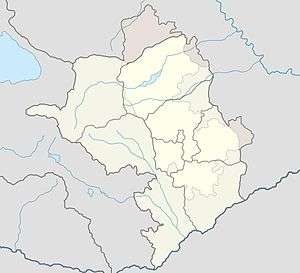Tigranakert of Artsakh
.jpg) Fragment of Tigranakert's city wall | |
 Shown within Nagorno-Karabakh Republic | |
| Location |
Martakert Province, Nagorno-Karabakh Republic (de facto) Agdam Rayon, Azerbaijan (de jure) |
|---|---|
| Coordinates | 40°03′55″N 46°54′21″E / 40.06528°N 46.90583°ECoordinates: 40°03′55″N 46°54′21″E / 40.06528°N 46.90583°E |
| History | |
| Builder | Tigranes the Great |
| Founded | 2nd-1st century B.C. |
| Site notes | |
| Excavation dates | 2005—present |
| Ownership | Government of the Nagorno-Karabakh Republic |
| Website | Тigranakert.com |
Tigranakert (Armenian: Արցախի Տիգրանակերտ, Arts'akhi Tigranakert) is a ruined Armenian city dating back to the Hellenistic period. It is one of several former cities in the Armenian plateau with the same name, named in honor of the Armenian king Tigranes the Great (r. 95–55 B.C.),[1][2] although some scholars, such as Robert Hewsen and Babken Harutyunyan, have posited that this particular Tigranakert may have been founded by Tigranes the Great's father, Tigranes I (r. ca. 123–95 B.C.).[3] It occupies an area of about 50 hectares and is located in the province of Martakert in the Nagorno-Karabakh Republic (NKR), de jure Aghdara in Azerbaijan, approximately four kilometers south of the Khachenaget River.
History
Primary sources first make mention of Tigranakert in the seventh century, stating that there were actually two such cities with the same name in the Armenian province of Utik.[4][5] Archaeologists and historians have managed to date the founding of the first one to the 120s-80s B.C., during the reign of either King Tigranes I, or his son and successor King Tigranes the Great.[6] Robert Hewsen has questioned the attribution to Tigranes II, as no coins or inscriptions bearing his have yet to be uncovered and the identification of the remains has rested on the local name for the site.[7] The ruins of the second Tigranakert have yet to be uncovered, although it is believed to have been located in the district of Gardman.[4]
After the demise of the first Tigranakert in the early Middle Ages, the name of the city was preserved and used continuously in local geographic lore as Tngrnakert, Tarnakert, Taraniurt, Tarnagiurt, and Tetrakerte.[1][4]
Excavations
Excavations at Tigranakert began in March 2005, when it was first discovered, and are currently ongoing under the directorship of Dr. Hamlet L. Petrosyan of the Armenian Academy of Sciences' Institute of Archaeology and Ethnography. Archaeologists have uncovered two of the main walls of the city, as well as Hellenistic-style towers and an Armenian basilica dating to fifth to seventh centuries.[6] In 2008, the excavation team began to face funding issues, although the authorities of the Nagorno-Karabakh Republic have promised to allocate 30 million drams to continue further research.[2]
In June 2010, a museum dedicated to the study and preservation of artifacts unearthed from Tigranakert's ruins was opened on the territory of the former city of Aghdam (which lie in ruins today).[6]
Gallery
 Tigranes the Great (95 – 55 BC), ruler of the Kingdom of Armenia.
Tigranes the Great (95 – 55 BC), ruler of the Kingdom of Armenia. Part of the city defense wall
Part of the city defense wall So-called Lower Borough of the city of Tigranakert
So-called Lower Borough of the city of Tigranakert Part of the Lower Borough
Part of the Lower Borough
 Ornamented capital from a column
Ornamented capital from a column Ruins of an early medieval Christian temple in Tigranakert
Ruins of an early medieval Christian temple in Tigranakert Professor Giusto Traina, an Italian historian who was a member of the international team exploring Tigranakert
Professor Giusto Traina, an Italian historian who was a member of the international team exploring Tigranakert
See also
References
- 1 2 Petrosyan, Hamlet L (2010). "Tigranakert in Artsakh," in Tigranes the Great. Yerevan, pp. 380-87.
- 1 2 Harutyunyan, Arpi. "Research in Ruins: Tigranakert project threatened by lack of finances." ArmeniaNow. April 11, 2008. Retrieved March 25, 2010.
- ↑ Hewsen, Robert H. (2001). Armenia: A Historical Atlas. Chicago: University of Chicago Press. pp. 58, 73, map 62. ISBN 0-226-33228-4.
- 1 2 3 Hewsen, Armenia, p. 58.
- ↑ Hakobyan, Tatul. "A city built by King Tigran the Great is unearthed." Armenian Reporter. September 26, 2009. Retrieved November 15, 2011.
- 1 2 3 "Museum at Ancient Ruins of Tigranakert Opens in Nagorno-Karabakh." Asbarez. June 8, 2010. Retrieved July 1, 2010.
- ↑ Hewsen, Robert H., "Three New Books about Arts'akh," Journal of the Society for Armenian Studies 22 (2013), p. 295.
External links
| Wikimedia Commons has media related to Tigranakert (Artsakh). |
- Tigranakert of Artsakh: (Armenian), (Russian).
- Zareh Tjeknavorian (Director) (2007). Tigranakert: An Armenian Odyssey. Yergir Union and Naregatsi Film Center.
- Tigranakert of Artsakh on CNN